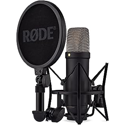The RØDE Broadcaster Microphone Appeals to Naturally Deep Voice Talents
End-Address Broadcast Condenser Microphone
The RØDE Broadcaster is a large diaphragm, end-address condenser microphone intended to deliver the optimum performance for broadcast voice applications.
It has become a standard in radio stations all over the world thanks to its rich, full-quality personalized response with an emphasized proximity impact. It works well as a voice-over microphone for radio, movies and television.
The integrated pop filter of the Broadcaster is intended to reduce the amount of plosives sounds that could overstimulate the microphone capsule and cause distortion in the audio output. A tunable high-pass filter of 75Hz is provided in addition to the Broadcaster’s original 20Hz–20kHz responsiveness, which will stop low-end noise like air conditioning units and traffic from being captured.
The revolutionary “On-Air” indicator seen on the body of the Broadcaster may be wired for external activation via the “Channel On/Mute” functionality on several consoles. When the microphone has electricity even when it isn’t attached to a console or switch, the indicator will always be lighted.
Australia-based RØDE produced the Broadcaster with a 10 year warranty that is the best in the business.
The depth of the Broadcaster’s bass was instantly apparent when we started recording. In order to get the finest sound possible, we also made sure that we didn’t have to get too close to the microphone.
Our voices sounded natural while being recorded by the microphone and weren’t compressed or overtuned. This microphone easily ranks among the best-sounding ones we have ever used. It has comparable audio quality to RODE’s Procaster but no compression.
A smooth and natural-sounding sound with great, sharp high-end clarity was produced by the microphone’s audio clarity. It was the best option for podcasting because it allowed us to live broadcast while requiring less EQing.
Since several of us who tried the mic had naturally deep voices, we set the low-cut setting at 75 hz. It performed admirably in contexts where ambient frequency was lower, such as streaming and broadcasting.
While writing this evaluation, we also noticed that, in contrast to most condenser mics, the Broadcaster had a more bassy quality. Other mics would require significant adjustment to perform similarly to the Broadcaster’s range.
The Broadcaster picked up a lot of these, unlike the Procaster mic which mostly blocked them. The Broadcaster performed better right out of the box than other condenser mics.
The Broadcaster has little noise after a few adjustments. It produced recordings with substantially better quality, which is great for many voice applications.
For applications where the Broadcaster may pick up vibrations from the associated stand/boom arm, we additionally advise using a shock mount.
In case you forgot, vibration + noise = This enables you to use a shock mount for the Broadcaster that is universally compatible.
Overall, the Broadcaster performed superbly, making it simple to suggest it for podcasting, voice-overs, and other uses. As RODE said, the audio quality is of broadcast-grade.










